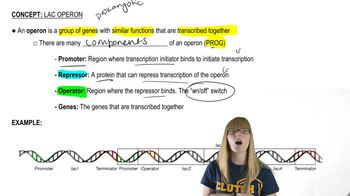Here are the essential concepts you must grasp in order to answer the question correctly.
Lac Operon
The lac operon is a set of genes in bacteria that are involved in the metabolism of lactose. It includes genes for permease, which facilitates lactose entry into the cell, and β-galactosidase, which breaks down lactose into glucose and galactose. The operon is regulated by the presence or absence of lactose, allowing bacteria to efficiently use this sugar when available. Understanding its regulation is crucial for analyzing how bacteria adapt to their environments.
Recommended video:
Anaerobic Fermentation
Anaerobic fermentation is a metabolic process that occurs in the absence of oxygen, allowing organisms like Lactobacillus to convert sugars into energy. During this process, lactose is fermented into lactic acid, which is essential for producing dairy products like yogurt and cheese. This pathway is vital for understanding how certain bacteria thrive in specific environments and how they contribute to food production.
Gene Regulation and Mutations
Gene regulation refers to the mechanisms that control the expression of genes, ensuring that proteins are produced at the right time and in the right amounts. In the context of the lac operon, mutations can lead to a loss of regulation, causing the operon to be constitutively expressed (always 'on') or not expressed at all. Such genetic events can include deletions, point mutations, or changes in regulatory sequences, which can significantly impact the organism's metabolic capabilities.
Recommended video:
 Verified step by step guidance
Verified step by step guidance Verified video answer for a similar problem:
Verified video answer for a similar problem:
